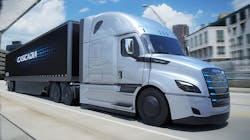This is Part 1 of a series examining modern diesel engines. Click here for Part 2
There may be a day when, more often than not, tractor-trailers are powered by lithium-ion batteries or stacks of hydrogen fuel cells— a day when diesel engines go the way of the dinosaur. That day is a long way off. Diesel engine manufacturers have no intention of fading into extinction just yet, but they are evolving.
And while hydrogen and electric hope to someday tread so gently treading they leave no carbon footprint at all, the latest diesel engines are far closer to near-zero-emissions than their black-smoke belching ancestors. And they are continuing to get even better.
It hasn’t all been by choice, as government regulations catalyzed the paradigm shift. Engine OEMs were forced to clean up their act here in the U.S. to comply with the 2007-2010 EPA emissions standards. Heavy-duty truck fuel economy standards, set by the EPA and National Highway Traffic Safety Administration (NHTSA), also went into effect in 2014 and will continue through 2027.
Despite resistance from fleets, these modern power sources—sometimes tasked with pulling 40 tons uphill—now drink less fossil fuel from the ground to travel the same amount and spew far fewer emissions into the atmosphere.
According to IHS Markit data, 43% of diesel-powered commercial vehicles on U.S. roads fall into this cleaner category, an increase of about 17% since 2015. And as these engines grab a greater market share, the world can breathe a lot easier.
“Since 2007, the newest-generation diesel trucks on U.S. roads have eliminated 126 million tonnes of carbon dioxide (CO2), 18 million tonnes of nitrogen oxides (NOx) and 1 million tonnes of particulate matter (PM), and saved 12.4 billion gallons of diesel and 296 million barrels of crude oil,” said Allen Schaeffer, executive director of the Diesel Technology Forum.
He says that’s the equivalent “to making 26 million cars all-electric, eliminating the PM emissions from all U.S. cars for 33 years, achieving carbon sequestration in a forest roughly the size of Texas, or creating a 27,000-turbine wind farm on land four times the size of Washington, D.C. – all benefits achieved thanks to the increasing adoption of the newest generation of advanced diesel engines.”
A key driver was implementing selective catalytic reduction technology, which filters out up to 90% of NOx and PM emissions by up to 50%.
Next year, stricter standards are expected to be enacted as part of the EPA’s Cleaner Trucks Initiative.
“The Cleaner Trucks Initiative will help modernize heavy-duty truck engines, improving their efficiency and providing cleaner air for all Americans,” said Andrew Wheeler, EPA’s acting administrator. “The U.S. has made major reductions in NOx emissions, but it’s been nearly 20 years since EPA updated these standards. Through rulemaking and a comprehensive review of existing requirements, we will capitalize on these gains and incentivize new technologies to ensure our heavy-duty trucks are clean and remain a competitive method of transportation.”
Truck OEMs such as Daimler are starting to deliver battery-powered eCascadias to targeted fleets for beta testing, and Nikola Motor Co. aims to produce zero-emissions hydrogen-fueled trucks at a 35,000-unit annual rate by 2022.
Neither seems able to seriously compete from a market perspective with diesel until the end of the next decade. There’s also the issue of fueling. Electric and hydrogen fueling stations could very well line the 101 along California’s coastline in a few years, but it will be far longer until Bismarck, N.D. and Lima, Ohio, receive similar infrastructure. There’s also the energy-intensive tasks of mining and processing lithium to make electric batteries and processing hydrogen fuel.
These aren’t reasons to abandon either “clean” tech, but they are reasons to continuously improve on the clean(ish) tech that works now: diesel.
And by 2030, the savings yielded by next-gen diesel engines are expected to grow exponentially, hitting 1.3 billion tonnes of CO2 (10X greater than 2007-present), 73 million tonnes of NOx (4X greater), 4 million tonnes of PM (4X greater), 130 billion gallons of diesel (10X greater) and 33.1 billion barrels of crude oil (11X greater).
“As we look to the future where new fuels and technologies may come more into focus, we can’t hit the pause button on progress today,” Schaeffer said. “These new findings reinforce the importance of the new generation of diesel in delivering vital societal benefits today in the here-and-now.”
And IHS projects diesel will still own the Class 8 majority through 2040. Humans could conceivably colonize Mars before diesel is usurped as the de facto fuel powering the transport of goods across the country.
“Experts agree: America’s truckers and fleet operators continue to depend upon diesel technology, and will for years to come,” Schaeffer concluded. “Especially for the largest of trucks, no other fuel matches what the newest generation of diesel technology offers: efficient performance, near-zero emissions, reliability, durability, low-cost operation, and maximum flexibility in utilization, routing and fueling.”
In Part 2, we will focus on how new diesel engines are helping fleets run more efficiently.
About the Author
John Hitch
Editor
John Hitch is the editor-in-chief of Fleet Maintenance, providing maintenance management and technicians with the the latest information on the tools and strategies to keep their fleets' commercial vehicles moving. He is based out of Cleveland, Ohio, and was previously senior editor for FleetOwner. He previously wrote about manufacturing and advanced technology for IndustryWeek and New Equipment Digest.



